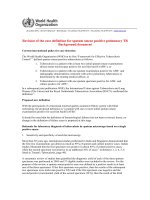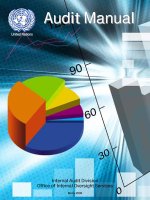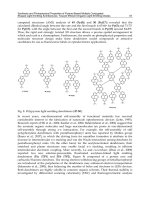Traning Process Approached Internal Audit(Change Background) doc
Bạn đang xem bản rút gọn của tài liệu. Xem và tải ngay bản đầy đủ của tài liệu tại đây (1.98 MB, 89 trang )
ISO/TS 16949
Process Approach
Inter nal Auditing Training
Nui Thanh, March 20 - 2013
Course Content
Session 1 ISO/TS 16949 Background
Session 2 Introduction to Auditing
Session 3 Audit Overview
Session 4 Audit Planning
Session 5 Conduct Audit
Session 6 Reporting Audit
Session 7 Post-audit Actions
Course Objectives
To provide participants with the necessary
competency in:
Planning & conducting Internal
Audit by using the IATF Process Approach
techniques
Reporting & following up the audit findings
effectively
STRIVE FOR EXCELLENCE
BERUSAHA KE ARAH KECEMERLANGAN
ISO/TS 16949
BACKGROUND
1
What is ISO/TS 16949?
Harmonization of automotive industry
requirements.
Developed by International Automotive Task Force
(IATF) and Japan Automobile Manufacture
Association (JAMA), supported by ISO/TC 176
Established based on major industry standard
ISO 9001:2000
AVSQ (Italian) , EAQF ( French) , QS-9000(U.S)
and VDA 6.1 (German) automotive catalogs.
Recognized by major European , American and
Japanese automotive manufacturer.
ISO/TS Development
1st Edition
ISO/TS 16949:1999
2nd Edition
ISO/TS 16949:2002
(OFFICIALLY PUBLISHED
ON 25 MARCH 2002)
3rd Edition
ISO/TS 16949:2009
ISO/TS Goals
Continual improvement
Emphasis on defect prevention
Reduction of variation and waste in the
supply chain
Intention of ISO/TS 16949
■ To avoid multiple certification
■ To provide a common QMS approach in
the Automotive industry
ISO/TS Scope
Flexibility:
ISO/TS 16949 becomes the common platform, other
customer imposed requirements are easily added on.
Customer
imposed
ISO/TS16949
Customer specific
requirements
Additional
Requirements
ISO 9001
Together with
customer-specific
requirements, ISO/TS
16949 defines the
quality system
requirements for use in
the automotive supply
chain.
STRIVE FOR EXCELLENCE
BERUSAHA KE ARAH KECEMERLANGAN
Introduction
toAuditing
2
What is audit ?
A ‘check & balance’ process to ensure activities are
performed in an appropriate and effective manner.
Usually conducted on an independent basis.
Objective evidence is required.
“ Systematic, independent and documented process
for obtaining audit evidence and evaluating it
objectively to determine the extent to which audit
criteria are fulfilled.”
Source: ISO 9000: 2000
Type of audits
Your own
Organisation
Certification
Body
Subcontractor
or Supplier
1st Party
(Internal Audit)
2nd Party
3rd Party
Purpose of Internal Audit
Assess the overall process control
Ensure conformance to the Documented
Quality System & Standards
Evaluate the effectiveness of the key
processes in achieving their objectives
Investigating problems (product or process)
Way of improving the current QMS
What To Look For During Internal Audit
3 key aspects of a process
Improvement
Effectiveness
Conformance
Conformance
What shall
be done
What is
actually done
vs
Conformance is the basic principle
Compare the actual activities against the audit criteria. In other words,
“do what have written and recorded down what you have done.”
Effectiveness
How do we know if a process is effective? It is
Able to maintain ‘mountains’ of documentation?
Able to follow Procedure strictly?
Able to produce results?
Effectiveness of a process is shown by the result it
achieved with the delivered output. Hence, auditors shall
look at indicator / measurable metrics to tell is customer
requirements are met.
Improvement
Look for trends
Compare current result against past results
3 types of internal audit
QMS Audit
To verify conformance to ISO/TS
16949 Standard & customer specific
requirements (CSR).
Manufacturing Process Audit
Focuses on the Manufacturing
Process within the total quality
management system.
Product Audit
Focuses on product characteristics
that lead to the verification of the
achievement of product requirements.
Product Audit
Manufacturing Process
Audit
Quality Management
System Audit
ISO19011
Ethical conduct
Fair presentation
Due professional care
Independence
Evidence based approach
Source : ISO 19011:2002
•
Environmental and quality audit
guidance standards are combined
in ISO 19011
•
Published in 2002
ISO 19011
Guidance on
quality and
environmental auditing
Common Internal Audit Failure
♦
Perceive audit as waste of time.
♦
Lackluster auditor selection
process
♦
Lack of proper system to train
auditors
♦
Inadequate process to evaluate
ability to perform audit.
♦
Over reliance on Quality
department
♦
Poor auditor judgment leads to
lack of confidence in internal
audit result.
♦
See auditor as fault finder or
trouble maker
STRIVE FOR EXCELLENCE
BERUSAHA KE ARAH KECEMERLANGAN
Audit Overview
3
Audit Cycle
1
2
3
4
Audit Planning
Conducting Audit
Audit Reporting
Corrective Action & Follow up
Audit Planning
1
Prepare annual audit schedule
Prepare audit plan
Prepare Checklist
Conducting audit
2
Conduct opening meeting
Collecting & verify audit evidence
Evaluate audit evidence against audit criteria
Audit Reporting
3
Auditor review meeting
Review audit finding with auditee
Conclusion & Report Writing
Closing Meeting
Corrective Action and Follow-up
4
Circulate Audit Report
Update Audit Schedule
Corrective Action performed
Verify completed actions
Close case









